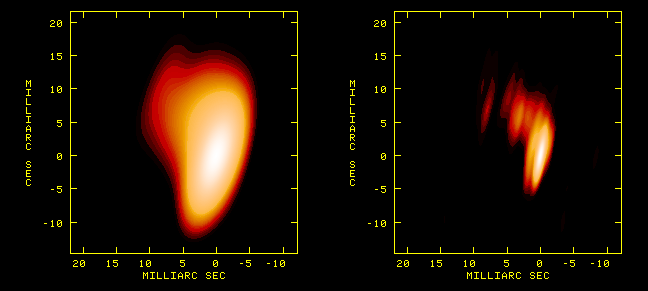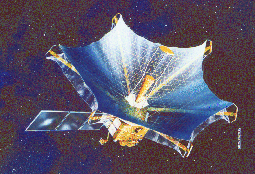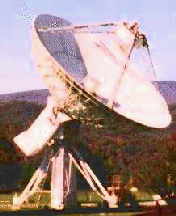

 Orbiting VLBI First Images
Orbiting VLBI First Images
A new radio telescope over twice the size of the Earth is now
producing its first pictures. This mega-telescope is made by
combining the signals from HALCA, an orbiting spacecraft with a radio
telescope, with those from many radio telescopes on the ground.
HALCA's elliptical orbit takes it as far as 21000 kilometers from the
Earth, making it possible to produce such an enormous telescope.
The HALCA satellite was launched on the 12th of February 1997 by
Japan's Institute of Space and Astronautical Science. The 8-meter
radio telescope, designed especially for this mission, was folded up
like an umbrella inside the spacecraft before the launch and then
successfully opened on the 26th of February using telemetry commands
from the Kagoshima Space Center on Kyushu Island, Japan.
Project Scientist for the VLBI Space Observatory Programme, Prof.
Hisashi Hirabayashi of ISAS, said "We are very pleased with HALCA's
first pictures. The clarity of the images made with HALCA confirms
that the chain from the satellite to the tracking stations, to the
orbit determination and the combining of the signals is all working
well. The success of this Japanese-led project is due to the hard
work of many engineers and scientists and the strong support of many
international partners."
The international character of this project is unique. Forty
telescopes from 14 countries around the world are being used with
HALCA; Tracking stations in four continents transmit data to, and
receive data from, the satellite; The signals from each telescope are
sent to one of three locations in Japan, Canada and the US, where a
special purpose computer called a correlator is used to combine the
signals from each telescope and where images are then made. Finally,
scientists from all part of the world have submitted proposals to use
this unique radio telescope over its expected five year life time.
HALCA's first image was made on June 15th of the quasar PKS1519-273,
and it showed only a point because of its very compact nature. This
was an important step in verifying the whole system since the image
was not blurred.
HALCA has also observed a distant quasar, called 1156+295, with ten
telescopes spread across the USA. The image of this quasar made from
the ground telescopes only is shown on the left. The strongest radio
signals are produced near the center of the quasar where astronomers
believe that hot gas and stars are interacting with a super-massive
black hole. On the right is another image of the quasar but with the
radio signals from HALCA added. The material which is being blown out
from the quasar can be seen more clearly. This unprecedented angular
resolution at the observing wavelength of 18 cm allows radio
astronomers to probe closer to the black hole in order to understand
the nature of such a mysterious objects.
Earth-based radio telescopes contributing to VLBI Space Observatory
Programme belong to the National Radio Astronomy Observatory (USA)
(which were used for the quasar images), the Australia Telescope
National Facility, the European VLBI Network, NASA's Deep Space
Network and a number of other institutions. The five tracking
stations are located at Usuda (Japan), operated by the Institute of
Space and Astronautical Science; Green Bank (West Virginia, USA),
operated by the National Radio Astronomy Observatory; and sites near
Goldstone (California, USA), Canberra (Australia) and Madrid (Spain),
operated as part of NASA's Deep Space Network. The signals from the
satellite and ground telescopes are combined at one of three
correlators operated by Japan's National Astronomical Observatory, the
Canadian Space Agency and the USA's National Radio Astronomy
Observatory. Orbit determination teams at the Institute of Space and
Astronautical Science and NASA's Jet Propulsion Laboratory have
provided the detailed predictions of the satellite's location and
velocity needed for tracking the satellite and correlating the data
from it.
Hundreds of quasars, radio galaxies and pulsars will be imaged with
this mega-telescope over the satellite's lifetime. These pictures
will have the sharpest view of the Universe ever achieved at these
wavelengths, up to 100 times the resolution of the Hubble Space Telescope.
HALCA, in Japanese, means `far away' which accurately describes the
location of the satellite at the farthest point of its 6-hour orbit.
The name HALCA is also an acronym for the Highly Advanced Laboratory
for Communications and Astronomy. The two way communications between
the satellite and tracking stations has been one of the technological
triumphs of the mission.
The first high resolution image from HALCA is shown below right.
The image on the left is the ground-only image of the radio source.
Notice the much improved angular resolution image made
using HALCA data.
 The two images above are of an extreamly high energy jet of particles
ejected from the center of the distant blazar 1156+295.
The bright white component in the center of the image is due
to material falling onto a giant black hole at the center of the
object. Magnetic fields surrounding the black hole accellerate the
particles into a narrow jet.
Return
to the tracking station home page.
The National Radio Astronomy Observatory
(NRAO)
is a facillity of the
National Science Foundation
operated under cooperative agreement by
Associated Universities, Inc.
The two images above are of an extreamly high energy jet of particles
ejected from the center of the distant blazar 1156+295.
The bright white component in the center of the image is due
to material falling onto a giant black hole at the center of the
object. Magnetic fields surrounding the black hole accellerate the
particles into a narrow jet.
Return
to the tracking station home page.
The National Radio Astronomy Observatory
(NRAO)
is a facillity of the
National Science Foundation
operated under cooperative agreement by
Associated Universities, Inc.
glangsto@nrao.edu Last update: 97 July 4




 Orbiting VLBI First Images
Orbiting VLBI First Images